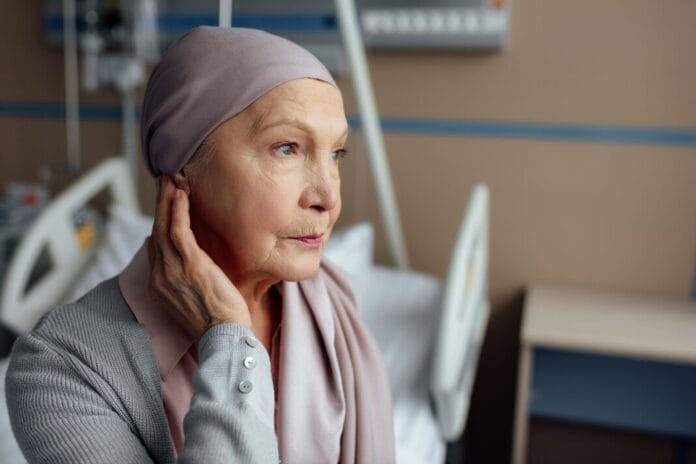The global population of older adults is expanding, with an estimated 22% of the worldwide population belonging to this demographic by 2050. This growth necessitates an assessment of health policies to support healthy aging, which is defined as the ability to maintain well-being, happiness, and fulfillment, not simply the absence of disease. Maintaining oral health is a necessary part of healthy aging, as it supports functional and social capabilities.1
The challenge of supporting healthy aging is compounded by the high prevalence of cancer in this demographic. Worldwide, an estimated 68% of the 19.3 million new cancer cases and 70% of the 10 million cancer deaths in 2020 were in individuals aged more than 65 years. While advances in treatment have prolonged lives, pre-existing age-related health issues and comorbidities, such as neurodegenerative diseases, chronic obstructive pulmonary disease, and diabetes, often complicate cancer treatment. These conditions, combined with poor oral health, can negatively impact outcomes and increase morbidity and mortality.1
Previous research shows a global increase in multidisciplinary oncology teams, including oncologists, medical specialists, geriatricians, primary care practitioners, and nursing staff, who collaborate to provide comprehensive geriacentric oncology care in hospitals and oncology centers. However, apart from head and neck cancer, oral healthcare professionals are generally excluded from these teams despite oral manifestations of cancer treatments.1
In addition, there is limited research suggesting the necessity and role of including an oral healthcare team to screen, prevent, manage, and treat the oral complications of cancer treatments, especially in older adults. To address this gap, a literature review aimed to “describe the need, role of, and factors influencing the integration of oral healthcare into the treatment of older people with cancer.”1
The Review
A narrative review design was chosen to combine and summarize the existing literature to formulate arguments for integrating oral healthcare in cancer care. For this review, 5 databases were searched: MEDLINE, CINAHL, PubMed, Scopus, and Web of Science. Only articles with participants above the age of 60 with cancer were included. The search retrieved multiple study types, including qualitative, quantitative, mixed methods, reviews, policy documents, and commentaries published between January 2012 and November 2023.1
The initial search yielded 1040 articles. Following the removal of duplicates and a manual review, 523 article titles and abstracts were screened, yielding 216 articles for full-text assessment. Of those, a total of 68 articles were selected for this review.1
The Results
The synthesis of the reviewed literature provided strong evidence supporting the integration of oral healthcare into the cancer care pathway. The findings of the reviewed articles were categorized into four categories:
-
- Oral complications due to cancer therapies
- The need for oral healthcare in older adults with cancer
- The role of integration of oral health in cancer care
- Factors influencing the integration of oral health in cancer care for older adults1
Oral Complications Due to Cancer Therapies
The studies in this review indicate that cancer treatment, such as chemotherapy, radiotherapy, hematopoietic stem cell transplantation, supportive therapies, and immune therapies, can have cytotoxic effects on oral tissues.1
Common oral complications and their effects include:
-
- Oral mucositits
-
- Leads to severe pain and discomfort in normal oral functions (chewing, swallowing, speaking)
- Can result in malnutrition
- Increases the risk of infection and often requires the use of opioids and hospitalization
- May potentially limit or interrupt cancer therapy in severe cases
-
- Xerostomia
-
- Increased risk of periodontal disease, caries, fungal infections (candida), and neuropathic pain
- Complications may lead to increased functional impairments
-
- Osteonecrosis, oral diseases, and infections
-
- Increased risk of oral ulcerations/mucositis, acute necrotizing ulcerative stomatitis, and fungal infections
-
- Dysgeusia, dysosmia, and dysphagia (taste and smell alterations, difficulty swallowing)
-
- Dysphagia can increase the risk of aspiration pneumonia and severe lung infections, resulting in increased mortality
- Can affect nutritional status
- Can reduce overall well-being, quality of life, and survivorship1
-
- Oral mucositits
The Need for Oral Healthcare in Older Adults with Cancer
Cancer and its treatment can cause both short-term and long-term oral complications, and the aging process significantly compounds this risk. Older adults are at a higher risk of oral frailty, which is age-related changes that compromise various oral functions, including the number of remaining teeth, saliva function, and overall capacity for maintaining regular oral healthcare. Cancer treatment adds an extra layer to oral frailty, worsening oral health outcomes. This added layer can lead to malnutrition and weakened immune response, which can negatively impact cancer treatment outcomes.1
The Role of Integration of Oral Health in Cancer Care
Cancer treatments can seriously affect oral health, causing complications that can lead to pain, infections, poor nutrition, fatigue, and potentially life-threatening conditions. Furthermore, oral complications in older adults with underlying health conditions may lead to premature cessation of cancer treatments, increasing the chances of morbidity and mortality.1
The call to integrate oral healthcare into the cancer care process is not a new concept – the National Institutes of Health first recommended it in 1989. Integrating oral healthcare in cancer care has been shown to reduce oral complications, improve treatment outcomes, quality of life, and overall well-being. Research shows that timely oral healthcare, with professional oral prophylaxis, can reduce the number of infective bacteria by 10–100-fold, reducing oral complications.1
Studies suggest that all patients with cancer should be referred to an oral healthcare professional for an oral exam, counseling, and basic oral hygiene instructions before the start of cancer treatment and every 3 months for the first year. Additionally, biannual maintenance visits are recommended to reduce bacterial levels and manage oral complications.1
When dental care is included in cancer care, it can help increase patients’ ability to eat, speak, and swallow, improve nutrition, improve treatment compliance, and improve overall well-being.1
Factors Influencing the Integration of Oral Health in Cancer Care for Older Adults
Evidence shows the importance of timely oral healthcare in managing and minimizing the impact of oral complications from cancer treatments. Yet, evidence remains limited for the integration of oral healthcare professionals into multidisciplinary teams treating older adults for non-head and neck cancers. This review highlighted four key barriers: healthy aging and ageism, oral health literacy, lack of interprofessional collaboration, and financial barriers.1
The first barrier is tied to societal perception of age and health. Good oral health is essential for healthy aging, yet limited attention has been given to this factor. Ageism in healthcare, such as assuming older adults need less care or excluding them from decisions, often leads to poorer patient outcomes. Oral health is often seen as a personal issue rather than a public health priority, and it is usually excluded from universal healthcare coverage and aging-related policies. Despite global efforts to support healthy aging, like the United Nations’ Decade of Healthy Aging toward Integrated Care for Older People (ICOPE), oral health remains overlooked in these initiatives.1
The second major barrier is oral health literacy. Poor oral health literacy leads to poor oral hygiene and delayed dental visits, which can increase the financial burden and interrupt cancer treatment.1
Because patients and caregivers often prioritize urgent medical needs over dental care, incorporating oral health education into cancer treatment can improve outcomes. Medical professionals and oncology team members play a critical role in emphasizing the importance of dental care to increase compliance with oral care and preventive measures.1
Though more research is needed, patient-centered solutions like home visits, telehealth, simplified instructions, and mobile apps show promise for improving oral health literacy and oral care throughout cancer treatment.1
The third critical barrier involves a lack of professional collaboration. This review found a significant gap in addressing the oral health needs of older adults undergoing cancer treatment, with only one study focused on this aspect of cancer care. Further, it found that patients trust their physicians and oncologists more than dentists for health communication regarding oral complications, making their referrals crucial for compliance.1
Nurses, a central figure in many cancer care treatment plans, are often overburdened and undertrained in oral healthcare. To complicate the situation further, many hospitals lack healthcare professionals with proper education and training to provide appropriate oral care for older adults with cancer.1
The review also highlights how technology can help overcome some of the barriers to oral care. Artificial intelligence and predictive analytics can be used for the early detection of oral diseases and the identification of high-risk individuals. Additionally, teledentistry, mobile apps, and digital patient records can help facilitate remote consultations and data sharing, ensuring consistent, coordinated, and flexible care. Innovative dental practice designs, such as wheel-chair accessible operatories and minimally invasive dentistry, are also recommended to improve access to care.1
Finally, financial barriers often make dental care inaccessible. Dental care is commonly viewed as non-essential for older adults, especially when they are already burdened by the costs of cancer or other serious illnesses. Factors such as high out-of-pocket costs, lack of dental insurance, and minimal government or global support make dental care inaccessible for many. As a result, poor oral health is often tolerated until problems become severe.1
Nonetheless, previous studies indicate that the long-term effects of avoiding dental care result in higher healthcare and societal costs. Delayed dental care also contributes to the exacerbation of systemic disease, increased rates of hospitalization, malnutrition, higher morbidity, and mortality.1
This review had limitations. While efforts were made to minimize citation bias and methodological limitations, the authors acknowledge their inability to fully address factors like socioeconomic status, geographic and healthcare system variations, age-related differences, and cancer treatment types.1
Conclusion
An approach that prioritizes health, function, and well-being over a disease-focused approach may help older adults with cancer maintain their dignity and independence. This review emphasizes the complex relationship between cancer treatment and oral health, ultimately suggesting that poor oral health significantly affects treatment outcomes, nutrition, psychosocial well-being, and overall quality of life.1
Despite clear evidence supporting the benefits of integrating dental care into cancer treatment, dental care during cancer treatment remains an area of health that is neglected. This neglect is based on multiple barriers, including ageism, poor oral health literacy, multimorbidity, oral frailty, financial burden, and a lack of interprofessional collaboration.1
This review provides support for policy reforms, including the integration of dental care in Medicare and global health agendas. The inclusion of oral healthcare in the global agenda for non-communicable diseases as “best-buy” by the World Health Organization could also provide an incentive for policy changes.1
Additionally, the review supports interprofessional education and the development of clinical guidelines and data-driven evaluations to close gaps in oncology oral care to improve patient outcomes, overall well-being, and quality of life for older adults with cancer.1
Before you leave, check out the Today’s RDH self-study CE courses. All courses are peer-reviewed and non-sponsored to focus solely on high-quality education. Click here now.
Listen to the Today’s RDH Dental Hygiene Podcast Below:
Reference
1. Anand, S., Visser, A., Epstein, J.B., Jalovcic, D. Necessity and Influencing Factors for Integrating Oral Health in Cancer Care for Older People: A Narrative Review. Support Care Cancer. 2024; 32(7): 461. https://pmc.ncbi.nlm.nih.gov/articles/PMC11222176/











